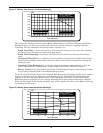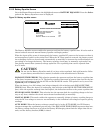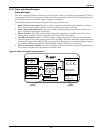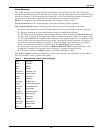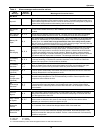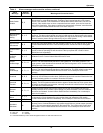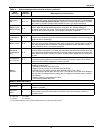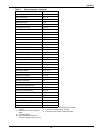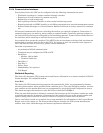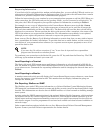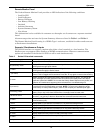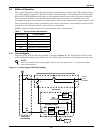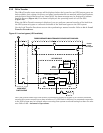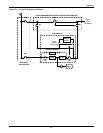
Operation
53
UPS SYSTEM, continued
Emergency
Off
D*, L, S
The Emergency Module Off (or Emergency Power Off) switch has been pressed, which
caused the UPS system to shut down and transfer the load to the bypass line (or all power
to the critical load has been shut down). Determine the cause of the emergency condition
and correct it if possible. Contact Liebert Global Services if you require assistance.
Battery Cycle
Buffer Warning
D, S
The Battery Cycle Monitor can retain information about the last 132 battery discharge
events. When the storage buffer approaches its capacity, this warning message is
broadcast via terminal and modem communication channels and a complete listing of all
records is sent to the terminal port. The message clears after 30 seconds.
COOLING
Ambient
Overtempera-
ture
D, R, S
The intake air to the UPS module exceeds the specified maximum temperature. This
condition only causes an alarm, but should be corrected immediately to prevent damage to
equipment due to overheating.
Blower Failed D, S
A fault in one or more of the blower motors has occurred. This condition only causes an
alarm, but if not promptly corrected it could cause an equipment overtemperature condition
that would shut down the UPS module. Check the blowers for proper operation. Contact
Liebert Global Services if you require assistance.
Equipment
Overtempera-
ture
D, S
Sensors on power semiconductor heat sinks detect temperatures above the steady state
limits for these components. The control logic sets off the alarm but does not shut down the
UPS module if the condition lasts less than 10 minutes. Check the air intake, air exhaust and
filters. Reduce the load or transfer it to bypass. Contact Liebert Global Services if the alarm
persists.
Overtempera-
ture Time-out
D, F
An Equipment Overtemperature condition has persisted for more than 10 minutes. The load
is transferred to the bypass line and the UPS module is shut down. Check the air intake, air
exhaust and filters before attempting to start-up the UPS.
Battery
Exercise
—
Battery self-test can be enabled from System Options screen. For test to start, the following
conditions must be valid:
1. No Battery Overtemp Alarm must exist.
2. Battery input and output circuit breakers must be closed.
3. All three input volt phases must be within nominal range (+10%, -20%).
4. DC volts must be greater than (DC Ref) -20V. For a 540 bus, the nominal float voltage for
240 cells (the DC voltage reference setting) the DC voltage on the battery must be greater
than 520VDC.
5. Battery charge must be greater than 90%.
6. Load must be greater than 15%.
REMOTE MONITOR PANELS
Load On UPS R The UPS is operating properly. No corrective action is necessary.
New Alarm R
Another new alarm message has been registered on the UPS system. Clear the new alarm
condition, if possible.
Summary
Alarm
R
One or more of the UPS module alarm messages has been activated. Use the Present
Status screen to determine which alarms are active. Clear the new alarm condition, if
possible to do so.
Table 4 Alarm messages and corrective actions, continued
Alarm
Message
Special
Functions Meaning and Corrective Action
D = auto-dial L = latches
E = logs only R = remote
F = freezes S = summary
D* = auto-dial initiated by Auto Transfer to Bypass if load is on UPS when alarm occurs



